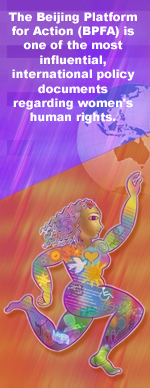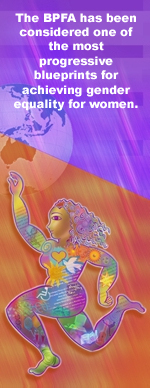Woman of the World - What about Beijing?
Woman of the World -
Know Your International Human Rights
- Preface
- What are human rights?
- What is the United Nations?
- The UN: Protecting the rights of woman
- What is CEDAW
- Australia's signing of CEDAW
- A guide to the rights in CEDAW
- CEDAW and the Sex Discrimination Act
- The Optional Protocol to CEDAW
- What about Beijing?
- What can you do: The public sphere
- What can you do: Private actions

The Fourth World Conference on Women:
In 1995, the Fourth World Conference on Women was held in Beijing, China. It is frequently referred to as the Beijing Conference. The Conference was the culmination of twenty years of work by the global women's movement, and resulted in the Beijing Platform for Action (BPFA).
The BPFA is one of the most influential, international policy documents regarding women's human rights. The UN Division for the Advancement of Women (DAW) organised the preparations for the Conference, the Conference itself, and follow-up processes that monitor and assess progress.
The BPFA has been considered one of the most progressive blueprints for achieving gender equality for women. It was negotiated and adopted by over 180 countries that attended the Beijing Conference. The document is divided into the following twelve critical areas of concern, each with its own principles and actions.
 A. Women and poverty
A. Women and poverty
B. Education and training of women
C. Women and health
D. Violence against women
E. Women and armed conflict
F. Women and the economy
G. Women in power and decision-making
H. Institutional mechanisms for the advancement of women
I. Human rights of women
J. Women and the environment
K. Women and the media
L. The girl child
The BPFA has provided the impetus for major improvements in women's lives around the world. For example, the section on Institutional Mechanisms provided women in many countries with the legal and international arguments for the establishment of national machinery for women's issues, such as the federal Office of the Status of Women that we already have in Australia. The BPFA is available at: http://www.un.org/womenwatch/daw/index.html
Beijing + 5:
Five years after the 1995 Beijing World Conference on Women, Beijing + 5 was held in New York. Beijing +5 was a five-day special session of the UN General Assembly to appraise and assess the progress achieved in the implementation of the BPFA around the world. The Special Session of the UN General Assembly on Beijing +5 took place in June 2000 and was called "Women: 2000: Gender Equality, Development and Peace for the Twenty-First Century."
The preparations for the Beijing Conference in 1995, and Beijing + 5 in June 2000, were conducted by the UN Commission on the Status of Women (CSW), which presented to the UN General Assembly the final documents of the meetings to be endorsed.
In addition to assessing progress in implementing the BPFA, the UN General Assembly also considered further actions and initiatives. Two documents were negotiated and adopted by the governments attending: the first is a short Political Declaration; the second is a lengthier document containing a review of the current implementation, and further actions and initiatives to implement the Beijing Declaration and the BPFA. This is the Outcomes Document.
Information about Beijing +5 is available at: http://www.un.org/womenwatch/daw/followup/beijing+5.htm
 Special Session of General Assembly, June 2000 - Beijing + 5 Outcomes Document:
Special Session of General Assembly, June 2000 - Beijing + 5 Outcomes Document:
The document deals with:
- achievements and obstacles in the implementation of the 12 critical areas of the BPFA;
- current challenges facing the full implementation of the BPFA; and
- actions and initiatives to overcome obstacles and to achieve implementation of the BPFA.
199 actions were agreed on to be taken at the national and international levels by governments, the UN system, international and regional organisations, including international financial institutions, the private sector, NGOs and others. A number of these actions set new targets and reconfirmed existing ones.
For a summary of the Outcomes Document go to the website of the Earth Negotiations Bulletin: http://www.iisd.ca/vol14/enb1446e.html
To view a copy of the latest version of the Outcomes Document go to: http://www.un.org/womenwatch/daw/followup.pdf
